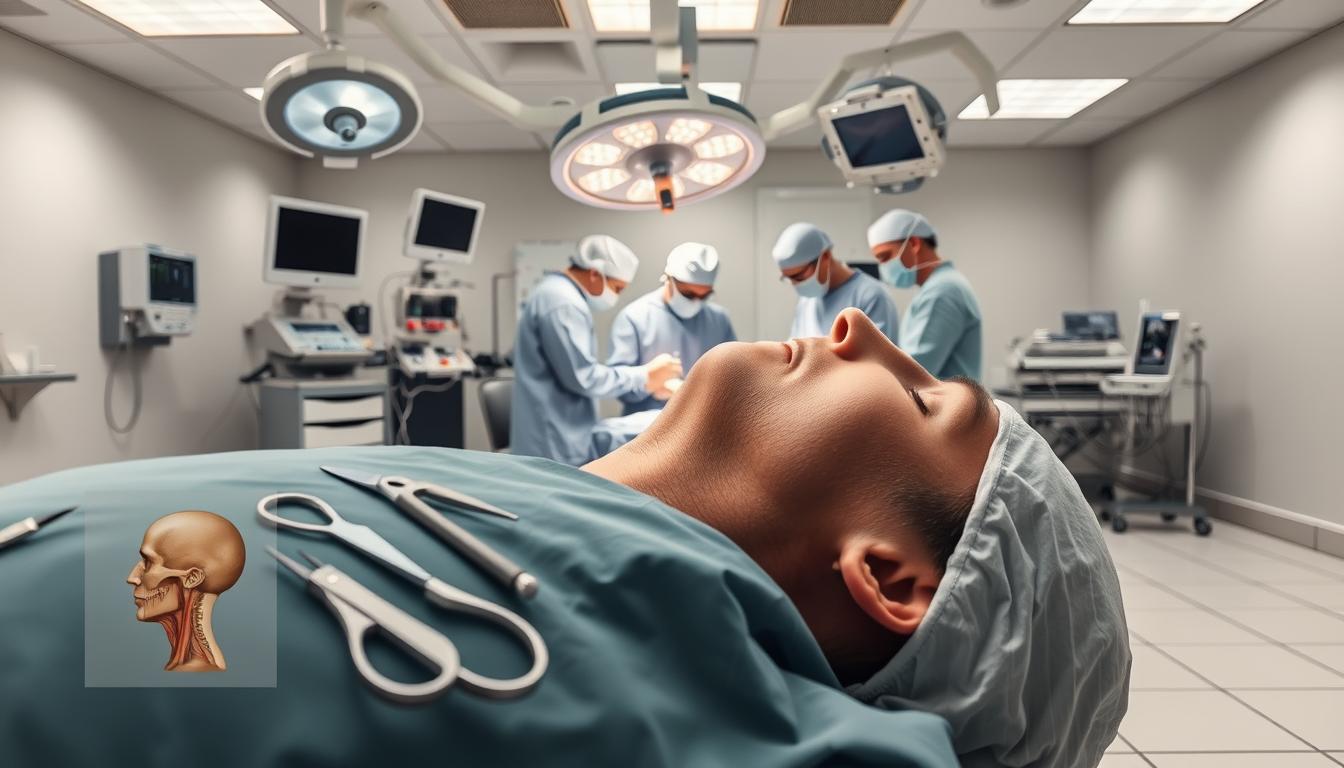Cosmetic surgery on the chin has become a significant advancement in facial aesthetic procedures, offering solutions for individuals dissatisfied with their chin’s appearance. Chin enhancement surgery, also known as genioplasty or mentoplasty, improves the contours of the chin, neck, and jawline.
Typically, surgery involves the placement of an implant around a patient’s existing chin bone to augment the size and shape of the chin and achieve a more naturally attractive balance between facial features. This procedure can dramatically enhance facial harmony by bringing the chin into better proportion with other facial features, thus improving the overall face appearance.
Key Takeaways
- Chin enhancement surgery improves the contours of the chin, neck, and jawline.
- Modern procedures include both implant-based and bone-modification techniques.
- A professional evaluation is essential to determine the most appropriate chin enhancement approach.
- Patients seek chin surgery for improved definition of the neck and jawline or to correct a weak or recessed chin.
- The chin plays a crucial role in overall facial balance.
Understanding Chin Cosmetic Surgery
Cosmetic chin surgery encompasses a range of procedures designed to improve the appearance of the chin and overall facial harmony. These surgical interventions are tailored to address various aesthetic concerns, enhancing the balance and proportions of the face.
What is Genioplasty and Mentoplasty?
Genioplasty and mentoplasty are specialized surgical procedures that modify the chin’s structure. Genioplasty involves altering the chin bone itself, while mentoplasty focuses on changing the shape or size of the chin. These procedures can address issues such as a recessed chin, asymmetry, or disproportionate chin size relative to other facial features.
How Chin Surgery Enhances Facial Harmony
Chin surgery enhances facial harmony by allowing for precise modifications that complement the patient’s natural facial shape and jawline. By adjusting the chin, surgeons can create a more defined profile, improving the overall aesthetic balance of the face and achieving facial harmony.
| Procedure | Description | Benefits |
|---|---|---|
| Genioplasty | Alters the chin bone | Improves chin size and shape |
| Mentoplasty | Changes chin shape or size | Enhances facial harmony |
Types of Cosmetic Surgery on Chin

The field of chin cosmetic surgery includes a variety of procedures designed to enhance facial harmony. Two primary types of chin surgery are chin implant surgery and osseous genioplasty.
Chin Implant Surgery
Chin implant surgery involves placing a chin implant directly on the bone via a short incision under the chin or inside the mouth. The implant is carefully selected to enhance the patient’s natural chin contour and facial profile, and is then secured with a titanium screw to prevent postoperative movement.
Key aspects of chin implant surgery include:
- Utilizing biocompatible materials, typically silicone, to enhance the chin contour.
- Creating a small pocket for the implant through a discreet incision.
- Securing the implant to prevent shifting or malposition.
Osseous Genioplasty
Osseous genioplasty, or bone repositioning, involves surgically cutting and repositioning the chin bone itself. This technique allows for comprehensive three-dimensional modifications, addressing complex aesthetic concerns such as chin height, width, and projection.
Benefits of osseous genioplasty include:
- Greater versatility for addressing complex aesthetic concerns.
- Tightening the soft tissues under the chin, creating a more defined neck contour and jawline.
Both chin implant surgery and osseous genioplasty have distinct advantages, depending on the patient’s specific anatomical structure and aesthetic goals. An experienced surgeon can help determine the most suitable procedure.
Benefits of Chin Enhancement Procedures
Improving the appearance of the chin through surgical means can have a profound effect on one’s overall facial appearance. Chin enhancement procedures are designed to create a more balanced and harmonious facial profile.
Improved Facial Proportions and Profile
Chin enhancement significantly improves facial proportions by creating a better balance between the chin, nose, and other facial features. A well-defined chin creates a more aesthetically pleasing profile, often making the nose appear more proportionate without the need for rhinoplasty.
Enhanced Jawline Definition
One of the most dramatic benefits of chin enhancement is the enhanced jawline definition it provides. This creates a clearer distinction between the face and neck, resulting in a more youthful and defined neck contour. Enhanced jawline definition is particularly beneficial as it can reduce the appearance of jowls or a “double chin.”

By improving the balance and harmony of facial features, chin enhancement procedures can boost an individual’s confidence. For men, a stronger, more masculine appearance can be achieved, while women may attain a more refined and balanced facial aesthetic.
The Surgical Process Explained
The surgical process for chin enhancement involves several key steps that are crucial for achieving the desired outcome. A successful procedure begins with a comprehensive consultation with a qualified surgeon who evaluates the patient’s facial proportions, chin structure, and dental occlusion to determine the optimal approach.
Pre-Surgical Consultation and Planning
During the initial consultation, the surgeon will perform a thorough evaluation and may use three-dimensional imaging to help patients visualize the potential results. This technology facilitates better communication of aesthetic goals and ensures that patients have realistic expectations about their chin surgery.
Anesthesia Options
To ensure patient comfort during the surgery, anesthesia options are discussed. These may include intravenous sedation or general anesthesia, with the choice depending on the complexity of the procedure and patient preference.
Incision Techniques and Placement
The surgeon will make a small incision either underneath the chin or inside mouth, depending on the chosen technique. The placement of the incision is critical to minimize visible scarring and ensure a natural-looking outcome.
Procedure Duration and Hospital Stay
The duration of the procedure varies based on the technique used. Chin implant surgery typically takes less than one hour, while more complex procedures like osseous genioplasty may take longer. Most chin enhancement procedures are performed on an outpatient basis, allowing patients to return home the same day.
Recovery After Chin Surgery
Recovery after chin surgery is a multi-step process that requires careful post-operative care. The process involves managing swelling, discomfort, and following specific post-operative instructions to ensure optimal healing.
Timeline for Healing and Swelling
The recovery process progresses in distinct phases, with initial swelling and bruising typically peaking within 48-72 hours post-procedure. Most patients can return to desk work and light daily activities within one week, although swelling may still be noticeable.
Post-Operative Care Instructions
Proper post-operative care includes sleeping with the head elevated for 1-2 weeks to minimize swelling and protect the surgical site. Surgeons often recommend a soft or liquid diet for the first few days, particularly for patients with intraoral incisions.
Managing Discomfort and Medications
Pain management typically involves prescription medications for the first few days, transitioning to over-the-counter options as discomfort subsides. Cold compresses applied during the first 48 hours can significantly reduce swelling and discomfort.
| Recovery Phase | Timeline | Key Considerations |
|---|---|---|
| Initial Recovery | 0-3 days | Swelling and bruising peak; pain management is crucial |
| Returning to Activities | 1 week | Most patients return to desk work; swelling may still be noticeable |
| Final Results | 3 months | Residual swelling subsides; final outcome is visible |
As one patient noted,
“The first few days were easier than I expected, thanks to the pain medication and cold compresses. Elevating my head while sleeping made a big difference in reducing swelling.”

Potential Risks and Complications
Understanding the potential risks and complications of chin surgery is essential for making an informed decision about undergoing the procedure. While chin augmentation is generally considered safe when performed by a qualified surgeon, there are inherent risks associated with any surgical intervention.
Common Side Effects
Common side effects of chin surgery include temporary numbness in the lower lip and chin area, which typically resolves within several weeks. Swelling and bruising are also expected aspects of the recovery process, though their duration and severity can vary among patients.
Possible Complications
More serious potential complications include infection, hematoma formation, implant displacement, or asymmetry that may require revision surgery. Patients with chin implants should be aware of the rare possibility of implant rejection or erosion over time.
Minimizing Risks Through Proper Surgeon Selection
Selecting a qualified, experienced surgeon is crucial in minimizing surgical risks. Board certification and specialized experience in facial procedures are essential qualifications. Thorough pre-operative screening and strict adherence to post-operative care instructions also significantly impact healing outcomes and help prevent complications.
Is Chin Surgery Right for You?
Determining whether chin surgery is the right choice involves a thorough self-assessment of your aesthetic goals. Ideal candidates are physically healthy individuals with realistic expectations who are dissatisfied with their chin’s appearance. A surgeon will assess whether chin surgery can achieve your desired results. Patients should be prepared to discuss their medical history and understand the procedure’s risks. By carefully evaluating your motivations and the surgery’s potential outcomes, you can make an informed decision about undergoing plastic surgery to enhance your chin.
FAQ
What is the difference between genioplasty and mentoplasty?
Genioplasty involves surgically altering the chin bone to change its shape or size, while mentoplasty typically refers to the placement of a chin implant to enhance the chin’s appearance.
How long does it take to recover from chin implant surgery?
The recovery period typically lasts several weeks, during which time patients may experience swelling and discomfort. Most people can return to their normal activities within a few weeks.
What type of anesthesia is used for chin surgery?
General anesthesia or local anesthesia with sedation is commonly used to ensure patient comfort during the procedure.
Will I have visible scarring after chin surgery?
The incision is typically made inside the mouth or under the chin, resulting in minimal visible scarring. The surgeon will take steps to minimize scarring and ensure a natural-looking result.
Can chin surgery be combined with other facial procedures, such as rhinoplasty?
Yes, chin surgery can be performed in conjunction with other facial procedures, such as rhinoplasty, to achieve a more balanced and harmonious facial appearance.
How long do the results of chin surgery last?
The results of chin surgery are generally long-lasting, with implants and bone repositioning providing a permanent solution.
What are the potential risks associated with chin surgery?
As with any surgical procedure, there are potential risks and complications, including infection, nerve damage, and scarring. A qualified surgeon will discuss these risks and take steps to minimize them.
